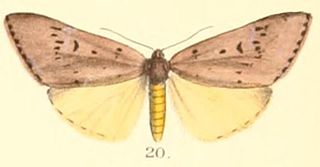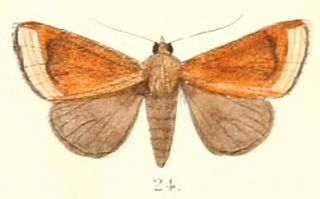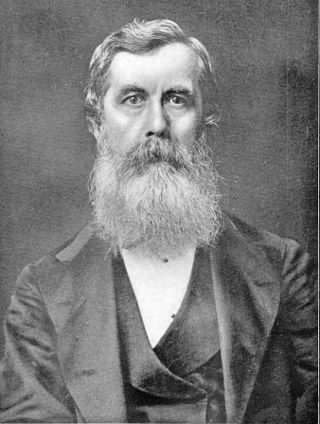William Stephen Atkinson was a British lepidopterist who worked for much of his life in India.

William Chapman Hewitson was a British naturalist. A wealthy collector, Hewitson was particularly devoted to Coleoptera (beetles) and Lepidoptera and, also, to birds' nests and eggs. His collection of butterflies, collected by him as well as purchased from travellers throughout the world, was one of the largest and most important of his time. He contributed to and published many works on entomology and ornithology and was an accomplished scientific illustrator.

Euploea klugii, the brown king crow or king crow, is a butterfly from the family Nymphalidae found in India and Southeast Asia. The species was first described by the entomologist Frederic Moore in 1858.

Adrepsa is a genus of moths in the subfamily Arctiinae first described by Frederic Moore in 1879.

Nikara is a genus of moths of the family Noctuidae described by Frederic Moore in 1882.

Mahoba is a genus of moths in the subfamily Lymantriinae. The genus was erected by Frederic Moore in 1879.

Colias erate, commonly known as the eastern pale clouded yellow, is a species of butterfly in the family Pieridae. It is found from south-eastern Europe, through Turkey over central Asia up to Japan and Taiwan. To the south, its range stretches to Somalia and Ethiopia. The species was first described by Eugenius Johann Christoph Esper in 1805.
Abrostola anophioides is a moth of the family Noctuidae first described by Frederic Moore in 1882. It is found in South-east Asia, including Darjeeling and Taiwan.

Baorisa hieroglyphica, also known as the Picasso moth, is a species of moth in the family Erebidae. It was described by the British entomologist Frederic Moore in 1882. The genus Baorisa was long thought to be monotypic, but three other species have been described. It is found in parts of northeastern India and Southeast Asia.
The Royal Glasgow Institute of the Fine Arts (RGI) is an independent organisation in Glasgow, founded in 1861, which promotes contemporary art and artists in Scotland. The institute organizes the largest and most prestigious annual art exhibition in Scotland - open to all artists.

Frederic Moore FZS was a British entomologist and illustrator. He produced six volumes of Lepidoptera Indica and a catalogue of the birds in the collection of the East India Company.
The Brentwood Library Site (40WM210), also known as the Jarman Farm Site, is a Mississippian culture archaeological site located in the city of Brentwood, in Williamson County, Tennessee. The substantial town was occupied during Regional Period IV of the local Mississippian chronology, and there was an associated burial ground, where nearly 50 stone box graves have been found. Artifacts from the site have been radiocarbon dated to between 1298 and 1465 CE. These include several types of Mississippian pottery, with Beckwith Incised found in the highest number.

Lepidoptera Indica was a 10 volume work on the butterflies of the Indian region that was begun in 1890 and completed in 1913. It was published by Lovell Reeve and Co. of London. It has been considered the magnum opus of its author, Frederic Moore, assistant curator at the museum of the East India Company. Frederic Moore described a number of new species through this publication. Moore was a splitter, known for careless creation of synonyms, sometimes placing the same species in more than one genus.

Aedia perdicipennis is a moth of the family Noctuidae first described by Frederic Moore in 1882. It is found in the north-eastern Himalayas of India, Nepal, Thailand, Myanmar, Taiwan, Singapore, Borneo, Sumatra and Sulawesi.

Blenina angulipennis is a moth of the family Nolidae first described by Frederic Moore in 1882. It is found in Taiwan and India.

Iambia transversa is a moth of the family Noctuidae first described by Frederic Moore in 1882.
Autoba angulifera is a species of moth of the family Erebidae first described by Frederic Moore in 1882. It is found in India.

Tangled: Before Ever After is a 2017 American animated musical fantasy television film produced by Disney Television Animation, that premiered on Disney Channel as a Disney Channel Original Movie. It takes place between the original Walt Disney Animation Studios film Tangled and the short Tangled Ever After, and serves as the first episode to Rapunzel's Tangled Adventure. It was directed by Tom Caulfield and Stephen Sandoval. The film centers around Rapunzel's adjustments to the life of a princess, and the mysterious return of her 70 feet (21 m) of magical, golden hair.

Mimathyma chevana, the sergeant emperor, is an Indomalayan butterfly of the family Nymphalidae. The species was first described by Frederic Moore in 1865.














